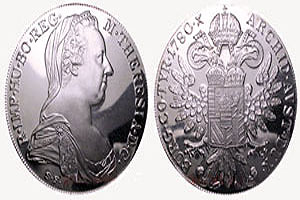
The Saudi Riyal: Evolution of a Currency
Riyadh, Asharq Al-Awsat – “I don’t know anything about Saudi currency, except that it is dispensed by ATM machines”, said Fahd al Amri, aged 25, as he paid for his shopping at a center in the Saudi capital.
Many Saudis, like Fahd, do not know the story of the “French Riyal” coin, which used to be widespread in Saudi Arabia, before the country was united by King Abdulaziz. It remained in use until 1928, when it was replaced by the Saudi Riyal.
Despite the French Riyal being minted in Austria and called a thaler (dollar), it was known in the Arabian Peninsula as the “French Riyal” and showed a portrait of Empress Maria Theresa on the front and the Habsburg Double Eagle on the back. In Najd, it was popularly known as “Abu Shosha”.
In a recently published book, “A Silver Legend: The Story of the Maria Theresa Thaler”, Clare Semple, noted that the Austrian dollar was widely used by merchants around the Arabian Peninsula from the end of the 17th century until the beginning of the 20th century. It was the currency of choice for many, ahead of the Spanish dollar and the Ottoman Majidi, because of its high silver content, as it weighed an ounce of silver, making it difficult to forge. With its ornate shape, the dollar was also used to make jewelry for women, including necklaces and earrings. Silver was cheaper than gold and considered less likely to bend, thereby facilitating the work of jewelers and enabling them to produce large ornaments.
Across the Arabian Peninsula, women would use the thaler as a charm to help them get pregnant. They hoped that the Austrian empress’ luck would rub off on them too, as she was blessed with 16 children. Men wore the dollar around their necks or as an amulet, believing its headed-eagle would bring them luck.
Following the “Desert Storm” operation in 1991 to liberate Kuwait, the Saudi government demanded Yemeni workers be sponsored by Saudis, thereby halting the transfer of money back to their families, according to Abdullah al Rimi, a wholesale trader in al Bathaa market in central Riyadh. Yemenis then found themselves obliged to search for the buried treasures of Austrian dollars, in order to provide them with financial liquidity to conduct their businesses. Convoys carrying thalers were seen heading from the markets of northern Yemen to Jeddah, a city well known as a center for currency exchange, to convert them into Austrian dollars.
Another popular currency was the Golden pound, which weighed 8 grams. It was commonly referred to as “Abu Khayyal” (the knight) as it pictured King George V. The coin was introduced from India and the parts of the Arabian Peninsula that were under British control. Ottoman currencies were also widespread, owing to their fixed weight and high caliber. They were known as the Majidiya. Other Indian coins such as the Rupee and Anan were also in circulation.
In the early 1930s, King Abdulaziz began to replace the Austrian dollar with the Saudi Riyal, which was also made from silver. He encouraged people to use it and even exchanged it with gold. However, when ordinary folk and traders alike refused to accept the new currency, the Austrian dollar remained in circulation for some time.
After the unification of Saudi Arabia by its founder Kind Abdulaziz, the first Saudi paper currency was introduced and was known as “Al Khaifanah”, as most people feared using paper money because it only carried a symbolic value, unlike precious metals such as gold and silver. King Abdulaziz then gave orders to issue a paper currency, known as the “Pilgrimage Cheque”, in three denominations, ten Riyals, issued in 1953, five Riyals and ten Riyals, issued in 1954, and one Riyal in 1956.
During the reign of King Saud, five denominations of Saudi currency were issued, including one Riyal, five Riyal, ten Riyal, fifty Riyal and one hundred Riyal. In 1977, after King Khaled became monarch, the first banknote carrying a picture was issued. The image of King Faisal was printed on all paper denominations in Saudi Arabia, except the one hundred Riyal note, which has a picture of King Abdulaziz printed on it.
The first banknote for 500 Riyals, carrying a picture of King Abdulaziz, was issued under King Fahd. In 1999, to mark the 100th anniversary of the foundation of Saudi Arabia, two paper denominations were issued, in addition to other notes that carried the picture of the ruling monarch. They are still in use in Saudi Arabia.
Salem al Bichi, a collector of old currencies, said the majority of Saudis do not collect paper or coin money. Despite the presence of old currencies in rural areas, their owners often do not realize their value and sometimes die without telling their loved ones where they have hidden them. “I found a golden pound in the room of an elderly lady, in a village in Asir. She refused to sell it to me, even for twenty thousand Riyals.” Two years later, he added, he returned to find that the woman had died and her house had been demolished.
The offices of the Saudi Monetary Agency include a Currency Museum, which charts the history of money and includes pre-Islamic currencies, as well as money used in more recent times, in five halls.
